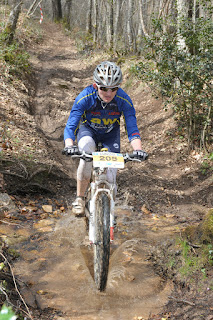When the UCI announced the death of the world marathon
series back in 2008, it left a lot of the world’s best long-distance racers
apparently bereft of a series to target with their respective seasons. The end
result was that marathon racing again became a more provincial concern, with
some racers choosing to concentrate their efforts on races in their “back
yard”, and a renewed focus for many on mtb stage racing. For three seasons, the
world has been without a marathon series, so many racers, both professional and
amateur eyed the new “UCI World Marathon Series” announced late last year, and
the associated world marathon champs qualification criteria with intrigue. The
criteria make it less the subjective choice of your particular governing body,
and more a question of simply being good enough.
Rachel and I intended to head to the Cevennes for the second
round of the new series, held in Thomas Dietsch’s particular back yard, and
started making plans with former team mate and friend Tim Dunford (Cannondale) late
last year to abandon our respective families for the Easter break. Before we
knew it, April was upon us, and it was time to head for the Tunnel and then
south through the heart of France to the sleepy town of Severac-le-Chateau. A
couple of good days weather and riding around the town left us all feeling
positive about the location and the race; Rachel and Tim were both hoping to
get their top-20 placing, and to punch part of their ticket to the worlds, I
had the more modest aim of rolling around to finish before dark!
We were sharing our gite with four more competitors, three
of whom (Mike Blewitt, Will Hayter & Collyn Ahart – MarathonMTB.com) were
fresh from the Cape Epic, having picked up Stu Spies in London. Unfortunately with
the other half of our party arrived the rain, which settled ominously over the
region the day before the race. Much talk was of what to wear and how to stay
warm in 4 degrees and drizzle, but in the end race day dawned cold but dry.
A quick check of the grid-plan revealed that I was on the 6th
row (better try not to get in anyone’s way!), and after a brief warm up to make
sure my legs were awake, we were off! The course revealed itself to be some of
my favourite sorts of riding, a pleasant mixture of the Surrey Hills in winter
and the Peak District in summer, with some short but brutal climbs. As the day
wore on, I learned many useful things:
·
Whilst a capable summer tyre for dry, dusty
trails, a Maxxis Aspen is not a great mud tyre.
·
On the day of Paris-Roubaix, French race organisers
are likely to include an homage to the Queen of the Classics – better attach my
spare tube more securely next time.
·
A totally dry XTR chain makes a very unpleasant,
very expensive-sounding noise.
·
Closing a flip-top gel sachet on your lip really
hurts!
(Rachel adds:
·
Losing your second bottle in the first 10km is
not very clever.
·
The pro riders probably avoid the inside of the
corner for a reason so you should not be surprised when your ‘clever line’ ends
in a big wheel swallowing rut.)
I finally rolled across the line a little over an hour after
the winner, Periklis Ilias, in 57th place, Rachel managed 11th
in the women’s race, and Tim worked his way up to 12th in our race
before blowing up and having to use only his granny ring to finish 40th.
This race is not for the faint-hearted, it packs in 2,800m of climbing into a
saw-tooth profile over 85km (65km for the ladies), and has the potential to eat
bikes and riders alike on a wet day. Staying with a group of seasoned marathon
racers who have competed all over the world our post race discussions brought
out where this race differs from many others and what made it so tough. There
are lots of little climbs (one every 5km-ish of race) rather than large
extended ones, making it tough for a group to stay together and share the work.
In addition, it was run off over a real mix of trail types which made for an
interesting course, but also required a lot of concentration. Finally, add in
some of the best marathon racers in the world, including a smattering of
national champions, and it’s not surprising you get a pretty spicy race. As the
race wore on, it was nigh on impossible to measure your effort well, and almost
everyone in our group described having ‘blown’ at some point. However, the
challenge is why we all do this and this makes the Roc Lassagais an even more
alluring challenge to me. Marathon
series or not, I want to come back again next year to race in Thomas Dietsch’s
‘hood!







No comments:
Post a Comment